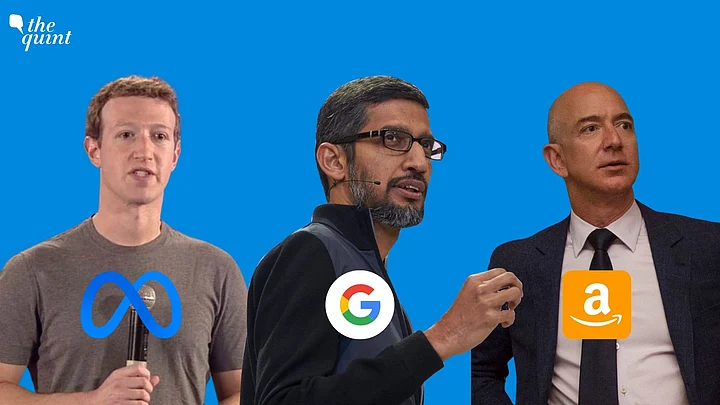While the pandemic was disruptive in a lot of ways, it marked a period of unprecedented growth for big tech companies. As people were forced indoors, ad revenues rose sharply on the back of increased use of social media and streaming platforms.
In 2020, for the very first time, Google, Meta, and Amazon earned more than half of the total ad revenue generated in the US. However, the gradual waning of the pandemic has put a dampener on things.
In the first three months of 2022, Google parent Alphabet's ad revenue grew by 22 percent, Meta Platforms' ad revenue grew by 6.1 percent and Amazon's grew by 23 percent.
Last year, however, these companies witnessed over 50 percent quarterly increases at certain points, according to The Wall Street Journal.
Apart from the lifting of lockdowns, Russia's invasion of Ukraine, a certain software update by Apple and increased competition from Tiktok have also pressured the three giants to re-evaluate their spending.
Stepping on the Brakes
Meta
The fourth quarter of 2021 was particularly rough for Meta. When the earnings were announced in February, Meta's shares plunged about 26 percent, erasing $250 billion or over a quarter of the company's market value.
For the first time in the company's 18-year history, Facebook saw global daily active users decline from the previous quarter. It also bet heavily on the Metaverse, which doesn't generate returns at this stage.
After the Q1 earnings, Zuckerberg said that Meta now plans to "slow the pace of some of our investments" due to "our current business growth levels."
The company is also reducing hiring targets and has stopped hiring across much of its engineering operation till the end of 2022 in order to limit expenses, Business Insider reported.
Alphabet
While Google search advertising, which accounts for nearly 60 percent of Alphabet’s total revenues, did well with 24 percent year-on-year growth, YouTube missed the mark in Q1 2022.
The advertising sales for the video platform grew only 14 percent to reach $6.87 billion, which fell short of expectations by over $600 million, according to Variety. For reference, YouTube's ad revenue jumped 49 percent in the first quarter of 2021 and increased 46 percent in the whole year.
YouTube is now testing ads on Shorts in an attempt to monetise its short form video product. Two types of ads, app install and video action campaigns, were mentioned.
Amazon
In Q1 2022, Amazon saw a net loss of nearly $4 billion even though it witnessed a 7 percent increase in net sales. It estimated that it would see another loss in the second quarter as well.
To keep up with demand, Amazon hired workers and built warehouses at a rapid pace. In its earnings call, the company admitted that it has gone from being understaffed to overstaffed, as growth in e-commerce sales slows down and labour costs rise.
Ad revenue has dropped and customers are likely to reduce spending due to rising fuel costs and inflation.
The Headwinds
Michael Nathanson, an analyst at MoffettNathanson told WSJ that he hadn't witnessed "a collective set of headwinds for advertisers like this since the early 1980s."
The Pandemic
The pandemic disturbed economic growth throughout the world. Consumers will now likely save more and spend less, which means businesses will want to curtail their spending on advertising as well.
Spending on digital ads globally is expected to grow by 13 percent this year (excluding political ads) which is considerably lower than the 30 percent growth recorded last year, according to media investment company GroupM.
The waning of the pandemic also means that people will spend less time and money on online shopping and entertainment, impacting ad dollars.
Russia's Invasion of Ukraine
Russia's invasion of Ukraine was countered by the West with a series of economic sanctions, causing companies (including Amazon, Meta, and Google) to suspend sales and services in Russia.
The supply chain issues caused by the conflict increased the prices of various products and commodities, including oil, leading to less expenditure on advertising.
Both Meta and Google confirmed as much. In their earnings reports, they indicated that the Ukraine war had caused a reduction in spending by brand advertisers, mainly in Europe.
Apple's Ad Policy
In a fresh push towards privacy, Apple introduced significant changes last April. It altered its iPhone software to require apps to ask users whether they want to be tracked, seriously limiting the ability to gather data used for targeted ads.
This has been a devastating blow, mainly for Meta. Chief Financial Officer Dave Wehner said the company expects the Apple policy to cost it more than $10 billion in lost sales for 2022 – about 8 percent of its 2021 revenue.
Wehner also suggested that Apple’s ad policy favours Google, reflecting the longstanding business relationship between the two.
TikTok's Explosive Growth
Another headwind for the advertising giants comes in the form of short video platform TikTok, owned by China's ByteDance.
After launching internationally in 2017, TikTok has already amassed 1 billion monthly active users, becoming one of the fastest-growing apps worldwide.
It is now poised to take a sizeable slice of the digital ad pie. According to eMarketer’s forecast, TikTok’s ad revenue is projected to jump 200 percent from $3.88 billion in 2021 to $11.64 billion this year, making it bigger than the ad businesses of Twitter ($5.58 billion) and Snap ($4.86 billion) combined.
By 2024, TikTok’s ad revenue is expected to double again to $23.58 billion, putting it in direct competition with YouTube which is expected to make around $23.65 billion by that time.
(With inputs from Bloomberg, The Wall Street Journal and Variety)
(At The Quint, we question everything. Play an active role in shaping our journalism by becoming a member today.)
